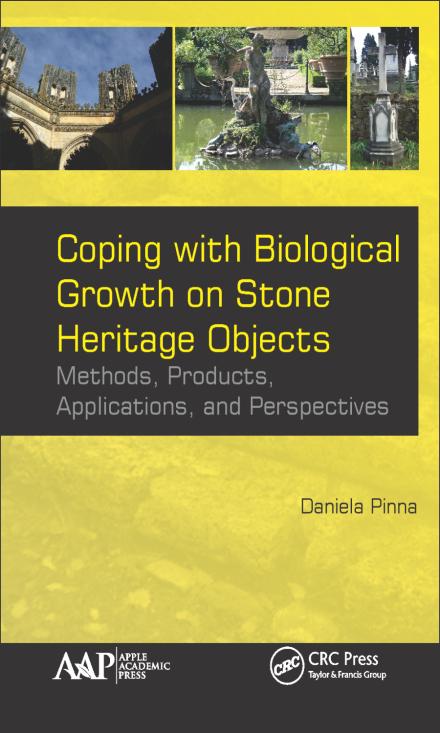Book Review: Coping with Biological Growth on Stone Heritage Objects Methods, Products, Applications and Perspectives
Submitted by sharragrow on

Review by Rosa Lowinger
Coping with Biological Growth on Stone Heritage Objects Methods, Products, Applications and Perspectives
By Daniela Pinna
Apple Academic Press, 2017
Hardback $169.95 / e-Book $152.96
360 pages / 34 black and white and 20 color illustrations
ISBN: 978-1-771885-32-4
Reading Daniela Pinna’s comprehensive compendium on biodeterioration brought to mind Alan Weisman’s “The World Without Us,” a non-fiction book in which the author envisions our planet if human beings suddenly disappeared and nature took over. Though Pinna’s authoritative volume is intended as a reference tool rather than a creative thought experiment, there is a striking poetic subtext to her book that echoes the subject of Weisman’s bestseller. If allowed to thrive unchecked, the irrepressible biosphere—bacteria, fungi, algae, mosses, lichens, vascular plants, and birds—will wreak havoc on anything built by humankind. As conservators, the job before us is to prevent and reverse the effects of these processes on heritage objects. The book aims to assist in that task by compiling and evaluating the last fifteen years of conservation literature on biodeterioration and its mitigation. Intended by the author as a “hands-on [guide] for facing the specific challenges involved in conserving monuments, sculptures, archeological sites and caves colonized by micro and macro-organisms,” it takes its inspirational reference from the Getty Conservation Institute’s 2008 Plant Biology for Cultural Heritage, while limiting its scope to stone objects.
Despite the restriction implied in the title, the book easily translates to all branches of heritage that are impacted adversely by the presence of bio-growth. As Pinna’s volume deftly reveals, this comprises our entire planet, including underwater environments. A biologist at the Italian Cultural Heritage Ministry, a lecturer in the Conservation-Restoration degree course at Bologna University, and the editor of a seminal 2009 work on the scientific examination of wall paintings, Pinna is a renowned heritage professional with a broad-reaching understanding of material processes that translates across conservation specialties. The book is well structured, and information is easy to access. Each chapter begins with an abstract of the material contained therein and each chapter’s content builds upon the information in the previous one. Pinna starts off with a chapter titled “Basic Principles of Biology.” At first this appeared oddly rudimentary for an advanced volume of technical knowledge such as this. However, the more I progressed through the material, the more I appreciated how that first chapter set the stage for what unfolds in subsequent pages. The structure of cells, the way they obtain the energy, carbon, and water that they require in order to flourish, is what incites the process of biological growth and subsequent deterioration of heritage objects. Indeed, in the abstract to this chapter Pinna recommends going back to it as one reads the subsequent chapters. As I pored over the chapters on the bioreceptivity of stone substrates--and physical and chemical characteristics that are more or less favorable to the propagation of living organisms, the detailed processes of biodeterioration, and the prevailing knowledge on control, eradication, and prevention of such deterioration by mechanical, physical and chemical methods--I found myself doing just that.
Surprisingly, this essential reference tool also includes many interesting bits of information that make the book enjoyably readable. Examples of this type of detail include the fact that biocides that have been developed for conservation all come from the medical and agricultural fields; that most algae that colonize heritage objects are green algae; and that the specific biostructure of lichens makes them particularly difficult to eradicate. I found myself highlighting for the pure pleasure of information as much as for professional edification. The only question I had about the structure is why the author included birds, but not other destructive pests from the kingdom of Animalia, such as rats, squirrels, insects, and bats. That said, the author references much information derived from other industries, evaluating processes for how they might be useful in the conservation of heritage. The sections devoted to the use of chemical biocides include daunting lists of products, many that are no longer in use due to toxicity or environmental impact. These lists are sobering reminders of the ongoing face-off between the built environment and biological worlds. The magnitude of case studies, many provided by José Delgado Rodrigues, a geologist and former Principal Researcher with Portugal’s National Laboratory for Civil Engineering (who also wrote the preface), is a testament to the fact that efforts to eradicate or control biological attack on heritage objects is a Sisyphean but nonetheless essential endeavor.
Comprehensive in its scope, well-structured and written, and thoroughly referenced in footnotes and appendices, this volume is an indispensable textbook for materials conservation educators and a well-written, informative hands-on tool for practitioners seeking to hold back the inexorable and never-ending assault of the biological world on stone and masonry.
AUTHOR BYLINE
Rosa Lowinger is president of RLA Conservation, Inc., a sculpture and architectural conservation firm with offices in Los Angeles and Miami. A Fellow of the AIC, she was the 2008-09 Rome Prize Fellow in Conservation at the American Academy in Rome. Rosa is the author of the 2005 nonfiction book Tropicana Nights: The Life and Times of the Legendary Cuban Nightclub, and numerous plays, articles, and essays about culture and conservation.